
 |
![]()
COMICS
|
foreign comic compilations (not for the last time) . This was the case in 1944 where Ellery was featured in the Spanish Pato Donald together with other comic book heroes of which Donald Duck was the most famous. |
|
| Right: Pato Donald, Issue 4 & 5, 1944. |
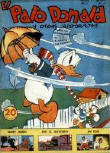 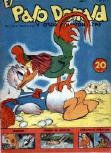 |
|
Although
Dannay once recalled there was talk of an Ellery Queen newspaper comic
strip it is said nothing came of it. The art in the following panels was done by Paul Norris and the feature was syndicated by King Features Syndicate. Norris, best known for his work on the comic strip Brick Bradford and Aquaman with Mort Weisinger was a prolific artist who also worked on Dashiell Hammett's Secret Agent X-9. He started to work for King Features after he returned from World War II. |
|
|
Above two panels
from the late 40s comic "House
of Darkness" by Paul Norris. |
|
| In The Evening Citizen, Ottawa (Jun 17. 1950) "The Case of the Invisible Lover" was published. The 3-page story was accompanied by a Paul Norris drawing, containing a 1947 copyright by King Features Syndicate Inc. Norris published similar work to accompany a 6 part publication of the short story "The Adventure of the Seven Black Cats" in Washington D.C.'s The Evening Star in September 1950 and The Times Union, Albany starting on December 28. 1953. | |
 |
|
|
|
|
 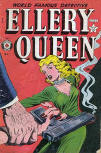 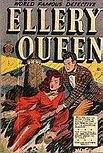 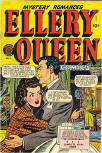 |
|
|
Above (L-R): Superior series #1 with artwork by LB
Cole contains the story "The Challenging Case of Faith, Hope and a
Charlatan!" Superior series #2 with artwork by LB Cole, includes stories "Terror Tide", "Calamity Clock," "Vanishing Phantoms", "Devil in the Vault". Centre story is "The Bell That Screamed" by Maxfield R. Pater. Superior series #3 featuring dope use, lingerie and torture scenes! Condemned by Frederuc Wertham. In "The Bubble Gum Mystery" Ellery discovers kids getting drugs that have been smuggled into the country inside bubble-gum balls. In "The Turbulent Tomb!" Ellery deduces how an isolated lighthouse keeper was killed in the middle of the storm. Contains some of the earliest drug stories. Find out how a practical joke by the Captain on Ellery helps solve the crime. Also, is it murder or can a pair of pyjamas be the reason for someone's death? Superior series #4 includes the stories, "The Case of the Seventh Raven" and "The Crooked Mile" artwork Jack Kamen |
|
In 1949 Ellery appeared for four issues in Superior Comics.
Despite the artwork by Jack Kamen, Matt Baker, L.B. Cole (#1),
John Forte and the S.M. Iger studio, the series
was essentially forgettable -- appearing bimonthly
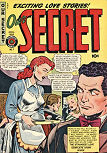 from May through
November. Written by Ruth Ann Roche. The fifth issue was in the works when
the title was canceled and the name of Ellery
was changed to Edmond Blake and Nikki to Nola.
The names were pasted over the original lettering.
To make things more confusing, Edmond Blake poses as Tim Keene in the story
(Ellery Queen posing as Tim Keene).
The 9 page story intended for unpublished Ellery Queen
nr 5. appeared in Our
Secret #7 (Apr 1950). from May through
November. Written by Ruth Ann Roche. The fifth issue was in the works when
the title was canceled and the name of Ellery
was changed to Edmond Blake and Nikki to Nola.
The names were pasted over the original lettering.
To make things more confusing, Edmond Blake poses as Tim Keene in the story
(Ellery Queen posing as Tim Keene).
The 9 page story intended for unpublished Ellery Queen
nr 5. appeared in Our
Secret #7 (Apr 1950).
|
|
 |
|
| Above: Original panel for the Our Secret story "Kiss and Tell" (1950). In the first panel you can see the original usage of the names "Ellery" and "Nikki". In the last panel some cut and paste work 'old style' to change "Ellery" into "Blake". | |
|
There were also Canadian editions of these comics.
Some of these comics were translated in foreign pulp magazines e.g. Pistas in Argentina
around 1950. The 4 EQ-stories were reprinted in Haunted Thrills
#'s 1 and 2 a few years later (6/52 and 7/52).
Accion
Policiaca, a 1953 comic book published monthly in Spanish by
Export Newspaper Service in New York City for Mexican Distribution also included
these stories. "Rest(less) in Peace" originally appeared in Ellery Queen #1, 1949 and continued as "Chant of the Dead" when it re-appeared in Strange Fantasy #2, 1952. Ellery by now became Jerry. The story was also found in 2 Eerie Publications Tales of Voodoo (v2, 1968) and Terror Tales (v3, 1969) as a 7 pages B&W reprint with some (blood, bats,...) alterations. Finally a 5 pages version found it's way into Horror Tales (v2, 1969). |
|
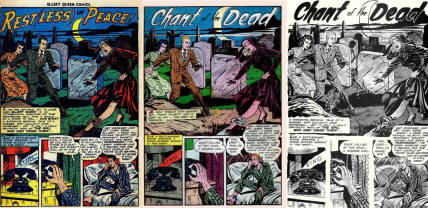 |
|
 |
|
|
EQMM) which was producing comic books then, chose to issue an Ellery Queen book in conjunction with the DuMont television series. The four stories where drawn by two artists one of the signed with "R. Kay". Some of the stories broke with the usual format by being just action-crime adventures instead of whodunits. Although topped of by great Norman Saunders painted covers, the book lasted just two issues (Spring and Summer of 1952), becoming more obscure than the Superior title that had preceded it. And although Ellery appeared in a several forms on television from 1954 through at least 1959, comic publishers avoided making the mistakes of their predecessors. Ziff Davis, was founded in 1927 by William Bernard Ziff Sr. and Bernard George Davis, as a New York publisher of hobbyist magazines, is unrecognizable today. |
|
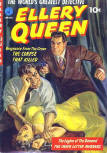 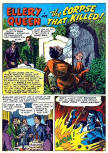 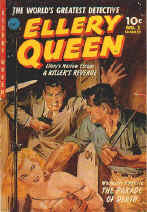 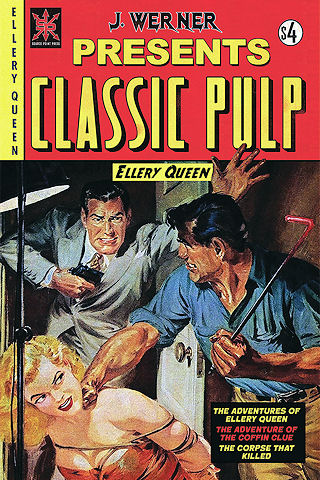 |
|
| Above: Ziff Davis' Ellery Queen included "Vengeance From the Grave" - "The Corpse That Killed" - "The Legion of the Damned" - "The Chain Letter Murders" and Slippery Slim in "The Hopeless Diamond". "The Corpse That Killed" re-appeared digitally restored in a Source Point Press publication with a collection Ellery Queen comics. "J. Werner Presents Classic Pulp" series (release Apr 29. 2020) was named Classic Pulp: Ellery Queen: Oneshot. | |
| Ellery's next appearance in comics was brought about by the same company that introduced him. Dell Publishing gave us Ellery Queen (Detective) for three issues of their Four Color series (1165, 1243, and 1289), dating 3-5/61, 11/61-1/62 and 4/62. This rendition of Ellery was somewhat modernized for the 60's but still carried the same basic plot concepts as earlier comics versions. Artwork was done by the late Mike Sekowsky and his Ellery differs from the rest by wearing glasses. | |
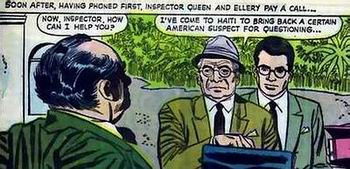 Above: Ellery and his dad in "Voodoo Victim" |
|
|
These comics were translated for different countries (e.g. Australia,...). Between '61 en '62 the publisher Zuid-Holland published a Dutch version (Nos. 1, 3, and 5 in a series of 6 issues). They were alternatingly published with an edition called De Detectives. Strangely enough the comic was printed in black and white. Also the extra trivia pages at the beginning and the end of the comic were omitted... From June1962 on Spanish editions of these three issues were published in Mexico for Editions SAE (Domingos Alegres presents). December 14. 2015 Coachwhip Publications republished the three Dell comics as one volume under the title Ellery Queen, Detective (A Dell Comic Reprint) . This volume collects the three Dell Four Color comics in the Ellery Queen, Detective, set. |
|
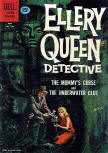
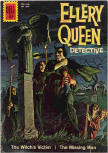
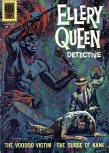 Above bottom (from L to R): Dell Four colour series N°1165 - 1961, N°1243 - 1961 - 1962 and N°1289 - 1962. |
|
 |
|
|
Despite all this Ellery again disappeared from the comics scene. Or did he? He actually did return in a spoof, in a comic called New Inferior 5 (Nr.7 March-April 1968) the five "heroes" encounter "Allergy Queen" the sleuth for a criminal mastermind. Right before his great revelation Allergy is reduced to dust...
|
|
| Above right: Detective Comics No. 459 - May 1976 On the cover one can clearly make out Alfred Pennyworth, the police, Batman unmasking, and Elliot Quinn’s corpse. (Art: J.L.Garcia Lopez - Editing Julius Schwartz) | |
|
|
|
|
|
|

|
|
|
Introduction |
Floor Plan | Q.B.I. |
List of Suspects | Whodunit?
| Q.E.D. | Kill as
directed | New |
Copyright Copyright © MCMXCIX-MMXXV Ellery Queen, a website on deduction. All rights reserved. |